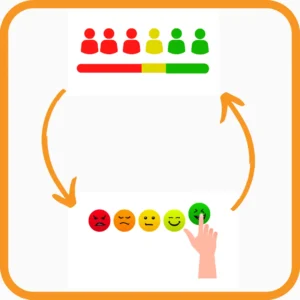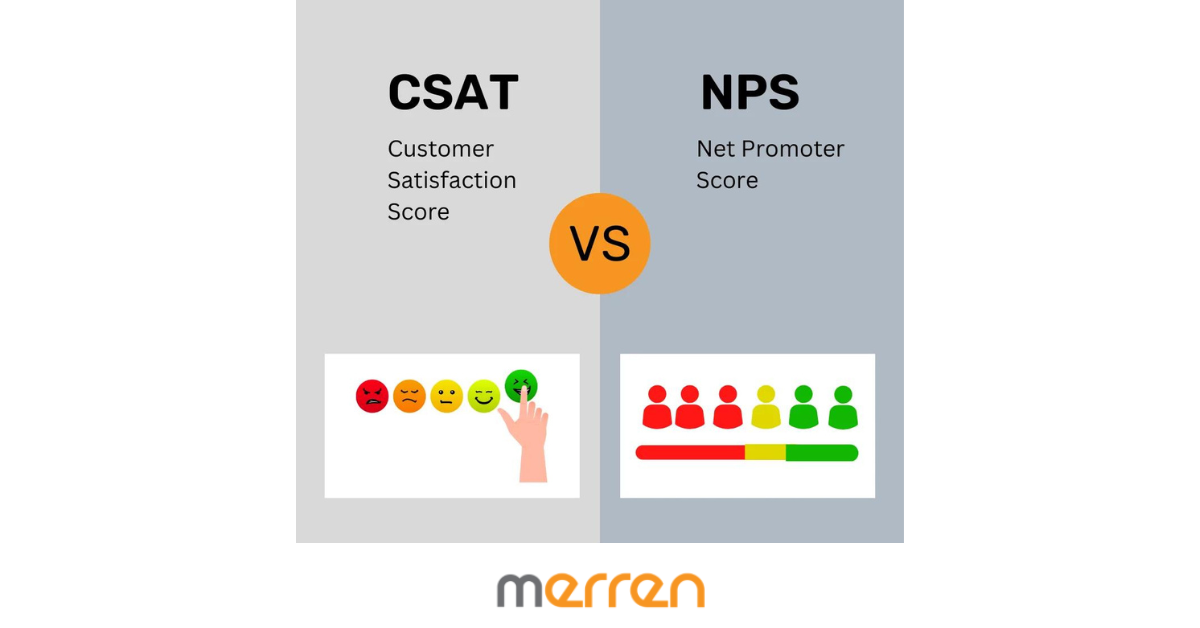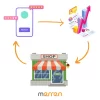Collecting feedback from your customer is a great way to understand your patrons, enhance onboarding experience for new customers and offer feasible solutions to any negative experience. Collecting intentional feedback at different touchpoints can give you an insight into their satisfaction level and comprehend customer sentiment better. In this blog, we will discuss the difference between customer satisfaction survey and net promoter score and how they measure customer satisfaction.
What is a customer satisfaction (CSAT survey)?
Customer satisfaction (CSAT) and net promoter score (NPS) are both customer satisfaction metrics that measure how satisfied customers are with a company’s products or services. However, they differ in terms of how these two metrics are calculated and the information the rating scale provides.
CSAT is a measure of how well a company has met a customer’s needs or expectations. It is typically measured on a scale of 1 to 5 or 1 to 10, with higher scores indicating higher customer satisfaction score. To calculate CSAT, a company will ask its customers to rate their satisfaction with a particular product or service on this scale. The average of these ratings is then calculated to determine the overall CSAT score.
There is standardized way of asking a CSAT question but usually they look like one of the following:
- On a scale of 1 to 5, with 1 being “very dissatisfied” and 5 being “very satisfied”, how satisfied are you with the product/service you received?
- On a scale of 0 to 10, with 0 being “extremely dissatisfied” and 10 being “extremely satisfied”, how satisfied are you with the product/service you received?
- How would you rate your overall satisfaction with the product/service you received? (Please select one of the following options: very satisfied, satisfied, neutral, dissatisfied, very dissatisfied).
- How satisfied are you with the product/service you received? (Please select one of the following options: extremely satisfied, very satisfied, somewhat satisfied, neither satisfied nor dissatisfied, somewhat dissatisfied, very dissatisfied, extremely dissatisfied).
- Please rate your overall satisfaction with the product/service you received. (Please select a number from 1 to 10, with 1 being “not satisfied at all” and 10 being “completely satisfied”).
What is a net promoter score (NPS survey)?
Net promoter score (NPS), on the other hand, is a measure of how likely a customer is to recommend a company’s products or services to others. It is measured on a scale of -100 to 100, with higher scores indicating a higher likelihood of recommendation/ referral. To calculate NPS, a company will ask its customers to rate the likelihood that they would recommend the company’s products or services to others on a scale of 0 to 10.
Customers are then divided into three categories: promoters (those who score 9 or 10), passives (those who score 7 or 8), and detractors (those who score 0 to 6). The NPS is calculated by subtracting the percentage of detractors from the percentage of promoters.
NPS is a more standardized measure with a fixed scale and the verbiage. The scale is always 0 to 10. The question always asks for the likelihood of recommendation. It can be noted that with scales like these, there is always an open ended question to capture qualitative data from the target audience. Some variation of the NPS question are as follows:
- On a scale of 0 to 10, how likely are you to recommend our company’s products or services to a friend or colleague?
- Please rate your likelihood to recommend our company’s products or services to others on a scale of 0 to 10, with 0 being “not at all likely” and 10 being “extremely likely”.
- How likely are you to recommend our company to your friends and family? (Please select a number from 0 to 10, with 0 being “not likely at all” and 10 being “extremely likely”).
Using the customer satisfaction metric- should you use CSAT or NPS?
CSAT and NPS are both customer satisfaction metric that will determine the overall experience a buyer goes through. There is no hard and fast rule for when to use customer satisfaction (CSAT) versus net promoter score (NPS). A good score might determine customer retention and current customer satisfaction levels. Here are a few points to consider when deciding which metric to use:
Objective of data collection
If the primary goal of the survey is to understand how well a company’s products or services meet buyer’s needs and expectations, CSAT may be the better choice. On the other hand, if the goal is to measure brand advocacy (word-of-mouth, buzz, recommendation) by its customers, NPS works better.
Benchmarking performance
NPS is a standardized metric. Almost every company that uses NPS asks a similar question (with minor variations) and uses the same scale (0-10). This makes NPS a more comparable metric across companies and categories. Many companies publicly share their NPS numbers making it easier for benchmarking.
Product category involved
Unlike CSAT, NPS does not work for all segments. NPS specifically asks for the likelihood of recommendation. Not all categories are ripe for recommendation. Commoditized, B2B, or sensitive categories (like condoms, undergarments etc) do not render themselves for recommendation.
Level of granularity
CSAT provides a more detailed view of customer satisfaction, as it allows a company to measure satisfaction with specific products or services. NPS, on the other hand, provides a more holistic view of customer satisfaction by taking into account overall satisfaction with the company and likelihood to recommend it.
Ease of calculation
CSAT is generally easier to calculate than NPS, as it involves averaging customer ratings on a simple scale. NPS requires more complex calculations, as it involves categorizing customers into promoters, passives, and detractors and then subtracting the percentage of detractors from the percentage of promoters.
Ultimately, the decision of which metric to use will depend on the specific needs and goals of a company. At times it may even be helpful to consider a combination of both CSAT and NPS to get a more well-rounded view of customer satisfaction.

Can CSAT be converted into NPS?
Short answer is, no. NPS is a standardized question asked in a specific way and on a particular scale. While mathematically one can rescale the CSAT data, there is still no way to change the verbiage of the question retrospectively. As the CSAT does not check on brand advocacy, converting CSAT into NPS would assume that satisfaction and brand advocacy are the same things. They may not be. As noted earlier, there are categories where a customer might be satisfied with the category but may not be comfortable or see a reason to recommend a brand.
Can NPS be converted into CSAT?
It depends. Mathematically, it is not very complex to remodel a CSAT scale (0-10) into a CSAT scale (1-5 or any other). Again, the assumption one makes when converting NPS into CSAT is that brand advocacy is the same as satisfaction. One can argue that the bare minimum requirement for brand advocacy is satisfaction with the brand. However, the implicit assumption of modeling NPS scale to CSAT scale is that the relationship between the two metrics is a linear one- which may not hold.
Here are a few best practices for collecting customer satisfaction (CSAT) or net promoter score (NPS) data:
- Make it easy for customers to provide feedback: Customers should be able to provide feedback in a way that is convenient and easy for them. This would include using the right medium (Whatsapp, Facebook Messenger, interactive and dynamic emails, AI chatbots and SMS/RCS etc) and using the correct language.
- Use clear and concise questions: The questions used to collect CSAT or NPS data should be easy for customers to understand and should not be lengthy or complicated.
- Use an appropriate scale: The scale used to measure CSAT or NPS should be appropriate for the specific goals of the survey. For example, CSAT is most often used with a 5-point scale but one can adjust based on the granularity needs. A 3-point or a 7-point scale work as well. Odd scales work better for CSAT as it provides a clear neutral point (for example: 3 is neutral on a 1 to 5 scale) but it does not necessarily have to be so. 10 point scales (1-10) are also not uncommon for CSAT, but anything beyond puts a lot of cognitive load on the customer.
- NPS has a standardized 0 to 10 scale and should always be measured using this scale only.
- Ask close to the moment-of-truth: Customer satisfaction feedback is best captured close to the time of the brand-customer interaction. At this point, the interaction is still relevant and fresh in the mind of the customer. This leads to higher response rate and better quality of response, untainted by the vagaries of the memory.
- Follow up on feedback: It is important for companies to follow up on customer feedback and take action based on the insights they gather. This could include addressing specific issues or concerns that customers have raised. This also includes making changes to products or services based on customer feedback. As far as possible, close the loop on the feedback by acknowledging and/ or acting on the feedback.
- Use data to improve customer experience: The ultimate goal of collecting CSAT or NPS data is to improve the customer experience. Companies should use the insights they gather to identify areas for improvement and make changes that will enhance the customer experience.
How does Merren help organisations capture customer feedback?
Merren is an end-to-end tool that works with real-time messenger based applications such as Whatsapp, Facebook Messenger and SMS/RCS. It helps capture personal insights at crucial touchpoints between customers and brands. Using these sync platforms, collecting impromptu customer data is easier, direct and candid.
➧Clients can choose from pre-existing templates or use the tools to create customized templates. Due to the informal tone of conversational surveys, customers find it comfortable to respond on-the-go. This brings in maximum valuable data which empowers organisations to make upgraded communication strategies.
➧The Merren mechanism is robust to collect feedback in the form of audio, video or pdf files. The tools can collect complex data at multiple points and segregate them as per filters for a bird’s eye viewing. The data can be tracked in real time and separated as per graphs, bars, pie charts and other filters set by the admin.
➧Merren can also be integrated with your CRM to push surveys across the customer journey. With this process, the entire feedback collection can be automated as per metrics set by you.
➧ Additionally, brands can translate surveys using the multilingual tool which can help customers comprehend better and share appropriate feedback. Customers can also hear the survey questions via ‘talk-back’ option. You can choose to translate from 70+ languages on the platform facilitated by Merren.
➧Branding is paramount and with Merren you can also opt for custom branding on the surveys. Our webhook integration enables brands to white label surveys before deploying them to your respondents.
Conclusion
A customer service team should curate the right kind of survey metric for their patrons at different touchpoints. One should remember that satisfaction metrics such as customer effort score (CES), CSAT and NPS are a way to put numbers to data. However, your patrons will still leave customer reviews on any social media app and online platforms. To elevate the overall customer experience CX , capture customer insights and build a support team equipped to contribute to the customer success.
To experience the Merren features first-hand, sign up for our 14 day free trial, no credit card required. We also offer one free consultation to guide you through the entire process. You can book a demo here.





